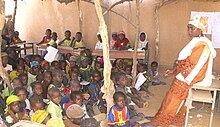Education in Niger
You can help expand this article with text translated from the corresponding article in French. (December 2017) Click [show] for important translation instructions.
|

Education in Niger, like that in other developing nations, particularly in the Sahelian region of Africa, faces challenges from poverty and poor access to schools. Although education is compulsory between the ages of seven and fifteen, Niger has one of the lowest literacy rates in the world.[1][2]
Organization of formal education
The education system of Niger is organized as such:[3]
- Pre-school (préscolaire)
- Primary school (enseignement primaire) (6 years)
- Secondary school (enseignement secondaire)
- 1st cycle (4 years)
- 2nd cycle (3 years)
- Higher education
- University: license (3 years), master's (2 years), doctorate (3 years)
- Technical institutes: DUT (University Technical Diploma Template:Fr (2 years)
Entrance to primary school is at age 7. Schooling is compulsory from ages of seven at the beginning of primary school to age fifteen at end of the 1st cycle of secondary school.[1][2]
Primary education
Primary education is composed of six grades:[3]
- C.I. (Cours d’Initiation or Initiation Class)
- C.P. (Cours Préparatoire or Preparatory Class)
- C.E.1 (Cours Élémentaire 1 or Elementary Class 1)
- C.E.2 (Cours Élémentaire 2 or Elementary Class 2)
- CM1 (Cours Moyen 1 or Middle Class 1)
- CM2 (Cours Moyen 2 or Middle Class 2)
Names of classes starting with CP come from the French system. CI was added to "initiate" students to the French language, which is the language of education in most schools.
Completion of primary school is sanctioned by a national exam. Successful candidates at the exam are awarded a certificate of completion of primary education or CFEPD (abbreviated from the French certificat de fin d'études du premier degré).[4][5][6] The World Bank cites the UNESCO Institute for Statistics' current estimate of primary school enrollment at 71%, though this figure is inflated because it counts the many overage children who are still in primary school.[7]
Some schools in Niger are trying a new approach to bring more girls into classrooms. However, there remains a disparity between the enrollment of boys and girls: from 51.57% and 48.43% in the first year for boys and girls, respectively. The enrollment decreases to 46.31% for girls by the end of primary school based on 2010 statistics.[5]
Tertiary education
There are five universities in Niger. The first and biggest, the Abdou Moumouni University in Niamey was founded as the University of Niamey in 1974. The Islamic University of Niger in Say was opened in 1986. In 2008, two public universities, the University of Zinder in Zinder and University of Maradi in Maradi were created. In 2010, the University of Tahoua or Universite de Tahoua was created in Tahoua. In 2014, it was announced that four additional universities will be created in Agadez, Diffa, Dosso and Tillaberi.[8]
References
- ^ a b Behnke, p. 40
- ^ a b "Niger" Archived 2008-12-05 at the Wayback Machine. 2001 Findings on the Worst Forms of Child Labor. Bureau of International Labor Affairs, U.S. Department of Labor (2002). This article incorporates text from this source, which is in the public domain.
- ^ a b [1]. Last accessed on 9/20/2014.
- ^ [2] Education for all in Niger. Last accessed on 11/2/2014
- ^ a b [3] Enseignement, Formation, Recherche. Last accessed on 11/2/2014
- ^ [4] Last accessed on 11/2/2014.
- ^ "School enrollment, primary (% gross)". The World Bank. Retrieved 9 February 2015.
- ^ Creation of Four Public University in Some Regions in Niger. Article published by the Agence Nationale de Presse on March 7th, 2014.Last accessed on 9/20/2014.
- Education Statistics Summary (2005). UNESCO Institute for Statistics.
- Profile of Niger's Educational System. Adama Maiga Oumar. United States of America, Department of State (2001).
- Galbreath, Mylani (2008). Niger in Pictures. Twenty-First Century Books. ISBN 0-8225-7147-1.
{{cite book}}: Cite has empty unknown parameter:|coauthors=(help) - Wynd, Shona (1999). "Education, Schooling and Fertility in Niger". In Heward, Christine; Bunwaree, Sheila S. (eds.). Gender, Education, and Development: Beyond Access to Empowerment. Palgrave Macmillan. pp. 101–115. ISBN 1-85649-632-5.
{{cite book}}: Cite has empty unknown parameters:|editor1link=and|editor2link=(help)

